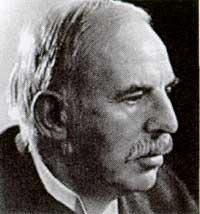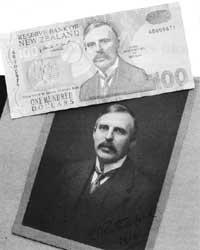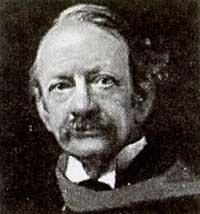Rutherford, Ernest
1995/08/02 Azkune Mendia, Iñaki - Elhuyar Fundazioa | Kaltzada, Pili - Elhuyar Zientziaren Komunikazioa
(1871-1937)
British physicist born in Nelson, New Zealand, in 1871. In his family there was not much money and like his parents, Ernest worked in the garden to get some money. However, he soon excelled at school and was awarded a scholarship to study at the University of New Zealand. He immersed himself in physics and studied when he invented the magnetic detector that detected radio waves.

In 1895 she was awarded a scholarship to study at the University of Cambridge. J. J. He studied with Thompson and after a season at McGill University in Montreal, he returned to England where he settled.
At that time he was completely concerned about radioactivity, fascinated by Becquerel's experiments and the Curie marriage. Rutherford was the first to distinguish alpha and beta rays. In 1900 he defined gamma rays as electromagnetic radiation without electric charge and high frequency. He believed that uranium could disintegrate into different elements under the influence of radiation and, based on this idea, came years later to the Soddy isotope hypothesis. In analyzing what the disintegration of an atom consists of, he calculated the time it takes to halve the number of atoms of a substance, establishing the concept of semivesity of radioactive elements. Between 1906 and 1909 he studied the alpha particle and deduced it to be the nucleus of helium.
In 1906 he performed the so-called Rutherford experiment at McGill University. Alpha particles were thrown into a thin sheet of gold. Most of the particles traversed the gold without deviating, a few changed their path by a variable angle and finally observed that some particles backed down the path they came. He completed his experiment at the University of Manchester and proposed a theory on the structure of the atom. According to this, the atom is like the solar system, that is, the central core and the electrons revolving around it. In 1908 he was awarded the Nobel Prize in Chemistry for his essays for the implementation of nuclear physics and chemistry. The radiation intensity unit is then called rutherford.
In 1919 he made the first artificial transmutation by bombarding with alpha rays, transforming nitrogen into oxygen. That same year he was appointed professor of physics at the University of Cambridge. Between 1925 and 1930 he was president of the "Royal Society" and in 1931 the English government awarded Rutherford with the Baron titles of Lord and Nelson.
The last years of his life were spent organizing aid commissions for Jewish scientists escaped from Germany. Although Hahn succeeded in melting uranium two years after Rutherford's death, he did not believe that man would fully dominate atomic energy.
Ernest Rutherford of Nelson, a renowned physicist and chemist, died in 1937 and was buried in the Westminster hut.

Gai honi buruzko eduki gehiago
Elhuyarrek garatutako teknologia





